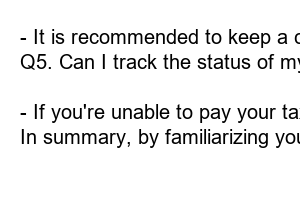연말정산 환급금 미리 보기
Preview of Year-End Tax Refund: How to Maximize Your Return
As the year comes to a close, it’s time to start thinking about your year-end tax refund. While it may seem too early to start planning, taking a proactive approach can help you maximize your return and ensure a stress-free tax season. In this blog post, we will provide you with a preview of what to expect and offer some tips to help you make the most of your refund.
1. Understanding the Year-End Tax Refund
– A year-end tax refund is an amount of money that taxpayers receive if they have paid more in taxes throughout the year than their actual tax liability.
– By taking advantage of tax deductions, credits, and exemptions, you can reduce your taxable income and increase the chances of receiving a refund.
2. Organize Your Financial Documents
– To ensure a smooth tax preparation process, it’s essential to gather all the necessary financial documents, such as W-2 forms, 1099s, and receipts.
– Organizing your documents ahead of time will help you identify potential deductions and ensure accuracy when filing your taxes.
3. Evaluate Your Tax Withholding
– Throughout the year, your employer withholds a portion of your paycheck for taxes. By evaluating your withholding, you can adjust it to better align with your tax liability.
– If you had too much withheld, you will receive a larger refund. On the other hand, adjusting your withholding can prevent overpaying and increase your take-home pay.
4. Take Advantage of Tax Credits
– Tax credits can significantly reduce your tax liability or increase your refund. Explore available credits, such as the Child Tax Credit, Earned Income Tax Credit, or Education Credits, and determine if you qualify.
– By understanding the eligibility requirements and claiming the credits you qualify for, you can maximize your refund.
5. Contribute to Retirement Accounts
– Contributing to retirement accounts, such as 401(k) or Individual Retirement Accounts (IRAs), may not only assist with long-term financial goals but also reduce your taxable income.
– By making contributions before the year-end, you can potentially lower your tax liability and increase your chances of receiving a refund.
6. Seek Professional Assistance
– Tax laws and regulations can be complex, and keeping up with changes can be challenging. Seeking assistance from a tax professional can ensure accurate tax preparation and help identify additional deductions or credits.
– Professional guidance can potentially save you time, reduce stress, and maximize your refund.
FAQs:
Q1. When can I expect to receive my tax refund?
– The timing of your tax refund depends on various factors, including how you filed your return (electronically or by mail) and if you chose direct deposit or a paper check. Typically, refunds are issued within 21 days from the date the IRS accepts your return.
Q2. What happens if I make a mistake on my tax return?
– If you realize you made a mistake on your tax return, you may need to file an amended return. The IRS provides instructions on how to correct errors and amend your return.
Q3. Can I receive a tax refund if I owe back taxes?
– If you owe back taxes, any refund you’re eligible for may be applied to your outstanding balance. However, if your refund exceeds the amount owed, you’ll still receive the remaining balance.
Q4. Do I need to keep a copy of my tax return?
– It is recommended to keep a copy of your tax return and all supporting documents for at least three years. This allows you to refer to them if needed, particularly during any audits or inquiries from the IRS.
Q5. Can I track the status of my tax refund?
– Yes, you can track the status of your tax refund through the “Where’s My Refund?” tool on the IRS website. This tool provides updates on the progress of your refund.
Q6. What if I can’t afford to pay my taxes?
– If you’re unable to pay your taxes in full, the IRS offers payment options, such as installment agreements or an offer in compromise. Contact the IRS to discuss your situation and explore the available options.
In summary, by familiarizing yourself with the year-end tax refund process, organizing your financial documents, evaluating your withholding, taking advantage of tax credits, contributing to retirement accounts, and seeking professional assistance, you can increase the likelihood of maximizing your refund. Stay informed, be proactive, and start planning early to make the most of your year-end tax refund.

